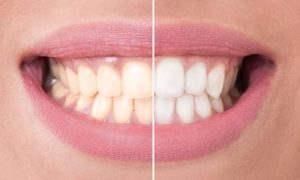Common Teeth Whitening Procedures for A Whiter Smile

Teeth losing their colour is quite common as your age increases. The inner dentine of the teeth appears darker as time passes and the outer enamel gets thinner. The outer layer gets worn out due to wear and tear. When the inner dentine is seen through the outer enamel, the teeth appear yellowish. Certain habits such as smoking or chewing tobacco, consuming food that are stain-causing like coffee or wine, consuming antibiotics for a long period – all these factors contribute to teeth losing their shiny appearance.
Teeth whitening procedures are generally of two different types. Intrinsic and extrinsic whitening procedures. Intrinsic procedures refer to the whitening of the dentine or the inner part of the teeth. Extrinsic procedures refer to the removal of stains on the enamel, the outer part of the teeth.
Professional teeth whitening
Teeth whitening is one of the most common cosmetic procedures people do at a dental clinic. The dentist usually photographs pictures before the treatment to monitor the progress of the treatment. Teeth are cleaned at the clinic before the whitening procedure. This is to remove the plaque or tartar build. Gums and surrounding soft tissues are covered before the process, to protect them from the action of the bleaching agent. A gel is applied on the teeth to start the bleaching.
Other types of whitening procedures use a certain type of laser light. After the whitening agent is applied on the teeth, light is shined on the teeth. Depending on the discolouration of the teeth, the results from the whitening procedure will change. Age, type of stains, heredity etc. affect the whitening outcomes. Procedures done at the dentist’s office are monitored and conducted under controlled conditions. They provide the best results. Another advantage of doing whitening at a dental clinic is that your dentist will first check the teeth to see if there are any cavities or cracks or gum diseases that need to be treated first. Dentists will not conduct the procedure until they are treated.
At home teeth whitening
Whitening can be done at home if you do not have time to visit the clinic. Whitening kits can be obtained from dental clinics. They can be custom made for you at the clinic. Impressions of the teeth are taken and sent to the lab to make the trays that hold the whitening material. Usually this takes about one to two weeks. Your dentist will guide you on how to use the bleaching solution and the tray.
You must clean and floss your teeth before the procedure. Whitening at home is typically done daily, but only for a particular period. Don’t continue after the specified time as it may cause damage to the teeth. Eating and smoking etc. should be avoided during and after the whitening.
Some types of trays can be worn overnight but some should be worn for a particular time say 30 minutes or so for each day.
Tooth pastes that whiten teeth
Tooth pastes do not help clean all types of stains, but can help with minor superficial stains that may be caused by coffee or smoking. Deep intrinsic stains cannot be removed using tooth pastes and will require professional care. Whitening tooth pastes contain abrasives that polish the teeth. They also have chemicals like peroxide that helps dissolve the stains. Both these ingredients work together to bring about teeth whitening.
There are other types of toothpaste that contain certain pigments that are uniformly deposited on the surface of the teeth. They create illusion that makes the teeth look less yellowish. Tooth pastes that have an ingredient called blue covarine give faster results than other whitening toothpastes. Usually they take about two weeks to show their effect. Following instructions given on the box is important for maximum results.
Since using these toothpastes can affect the teeth and oral health, make sure that you use only the ones that are approved by the medical association. Some toothpastes have a larger amount of abrasives and can cause more harm than good, and some destroy the good bacteria in the mouth. If unsure, seek advice from your dentist about the brand of toothpaste to use. The same rule affects any products that are brought over the counter without prescription from a dentist.
Over the counter whitening agents
Over the counter whitening products are available in stores and supermarkets. These products are an alternative to whitening procedures at the clinic. Whitening strips are favoured by many people. Strips are stuck on the teeth and pulled out after the specified time. They are to be kept on for around 30 minutes or so.
A different variety of whitening strips are available for those with sensitive teeth. It works the same way as the normal whitening strip. Those with sensitive teeth can also opt for mouthwashes that contain the same ingredient as whitening strips but are known to take a longer time for the desired effect.
Before using any over the counter products, it is important to check the ingredients first. Some may be harsh and can cause damage to the protective dental enamel.
Whitening at the clinic is always the more preferable and recommended option. However, if you are pressed for time and do not have regular access to a dentist you may try other options as required. For serious whitening, especially intrinsic whitening, you have to approach a dentist.
After your teeth are whitened, also make sure that you don’t fall back into earlier habits like smoking, drinking coffee etc. that may again dull the colour of your teeth.
